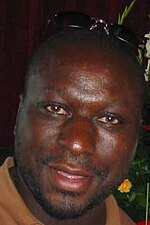| Joof family (Njuufeen) | |
|---|---|
 The totem and symbol of the Joof family is the antelope and gazelle, symbolizing grace, royalty, wisdom, hard work and protection in Serer mythology. | |
| Country | Kingdom of Baol Kingdom of Saloum Takrur (the Serers lineage Senegal (present-day) Gambia (former colony of Saloum) Mauritania (previously as Lamanes) |
| Founder | Lamane Jegan Joof (c. 11th century) Maad Ndaah Njemeh Joof(c. 1290) |
| Final ruler | Maad a Sinig Mahecor Joof (King of Sine, 1924-69) Maad Saloum Fode N'Gouye Joof (King of Saloum, 1935-69) Lamane Njaga Dibor Ndoffene Joof (Lamane Diaga Dibor Ndofene Diouf) - Lamane of Tukar (2004) |
| Titles | Lamane Maad Maad a Sinig Teigne Maad Saloum Bour |
| Dissolution | 1969 (last kings of Sine and Saloum), 2004 last known Lamane of Tukar. Sine and Saloum reinstated their monarchies as constitutional monarchs in 2019 and 2017 respectively. Maad a Sinig Niokhobaye Fatou Diène Diouf is the current King of Sine as of 2025 (reign 2019―present) [1] |
| Cadet branches | |
The Joof family is one of the old Senegambian royal families of Serer ethnicity.
Contents
- History of the Joof family
- The Lamanic era
- The Wagadou period
- The Guelowar period
- Historic battles involving this family
- Genealogy
- Status in Serer religion
- Personalities with the surname Joof, Diouf, Juuf or Juf
- Royalty
- Academic world
- Politics
- Legal profession
- Medicine
- Sports
- Music and entertainment
- Visual arts
- Business and commerce
- Multi-discipline
- Other
- See also
- References
- Bibliography
The surname Joof, also spelt Juuf or Juf (in Serer and Cangin), Joof (English spelling in the Gambia) or Diouf (French spelling in Senegal and Mauritania), is a surname that is typically Serer. Though there are multiple spellings for this surname, they all refer to the same people. The differences in spelling came about because Senegal and Mauritania were colonized by France, while the Gambia was colonized by the United Kingdom. Although spelt differently, they are pronounced the same way.
The totem and symbol of the Joof family is the antelope and gazelle, the symbol of grace, royalty, wisdom, hard work and protection in Serer mythology. The name of their clan is Njuufeen (in Serer). [2] [3] [4] The Joof family of Guelowar matrilineage also have another totem called Mbossé (a form of lizard, as in the Mbosseh festival [5] ). [6] They are the only ones permitted by custom and the rules governing totemic prohibitions to make libations to this reptile (not be confused with the primordial tree in Serer cosmogony) [6] Members of the Joof family from other Serer maternal clans also have their own maternal totems (see that article).
Members of this family had ruled over many of the pre-colonial kingdoms of Senegambia, including the Kingdom of Sine, the Kingdom of Saloum and the Kingdom of Baol. The royal princesses (Lingeers) from the Joof family were also given in marriage to the pre-colonial kings and princes of Senegambia. Some of these included the kings of Jolof, kings of Waalo, kings of Cayor and Baol (after 1549 following the Battle of Danki). From these marriages, they provided many heirs to the thrones of these kingdoms. [7] [8] Although usually associated with Serer royalty, the Joof family also figure prominently in Serer religious affairs.






